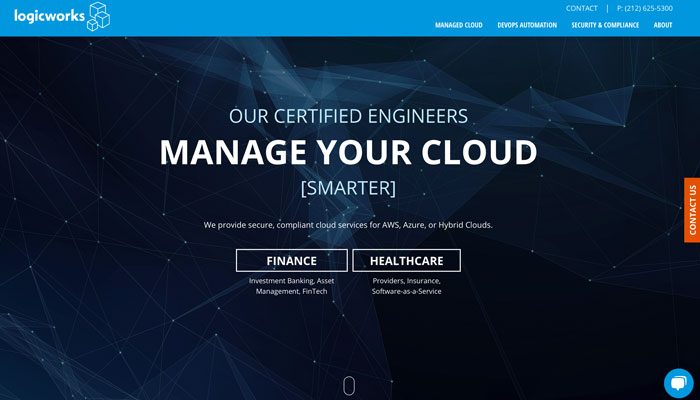What makes a website good in your opinion?
Easy navigation? Keywords for optimization? A contemporary looking design?
If any of those responses are your answers, you’re right of course. Chances are good you’ve got the essentials covered.
But optimizing your website for new business is a whole other ball of wax. If you’re trying to take your site from the back alleys of “Digital Brochure Town” to the penthouse suite of “Fat Sales City,” you need to start addressing the subtle nuances that will influence your relationship with visitors.
Better Conversion Paths for Leads
A “Contact Us” page is just not enough anymore.
Yes, it needs to be there. People will reach out to you when they are ready to buy, but how often does that happen? Once a month or less?
Most website visitors are not ready to buy anything. They are researching a problem with their tech infrastructure or data management. Maybe they stumbled across an interesting blog post your team wrote and wanted to learn more.
{{cta(‘523c515e-095c-4e12-bb96-7e3a85a7d665’)}}
Either way, you are usually not dealing with someone who’s going to hit the “Contact” button and run into your open arms with cash trailing from their hands. What can you do instead?

Try setting up some well placed conversion paths on your website. Insert a call-to-action button in key places that brings them to information that’s relevant to their challenges.
Educate them, and when the offer has enough value (and it has to be outstanding), ask them to fill out a form to get it. People move through the buyer’s journey at their own pace. Stay beside them and answer their questions at every stage of the process, and you will cross the finish line with them.
Thousands of IT companies are getting qualified leads this way. Your organization should be too.
Get Rid Of Sliders
I’m going to go point blank on this one: Sliders are terrible.
Instead of a focused, compelling message on the homepage, people are treated to a dizzying carousel of non-memorable stuff.
Assuming visitors have time to actually read the first slide (often not the case), they don’t have a moment to ponder how it relates to their goals before another, completely different message is pushed in their face. And then another, and another…
What are people supposed remember about this experience?
Companies use sliders because they are afraid to decide on a single value proposition, and it hurts the user experience.
Your organization might have many services, all equally important, but they should be interconnected in some way, solving an over-arching problem for customers. Your task is to boil down these offerings and explain how you solve this critical need in the most effective way possible.
Don’t take my word for it — there is growing evidence that sliders just don’t work. Let’s replace them with something that helps people.
Focus On Niche Industries

Check out this beautiful example of niche marketing from Logicworks. Mmm-mmm, good!
As Luke Hawley so eloquently stated about the evolution of business in the digital world:
The late 90’s were about getting connected.
The 2000s were about getting connections.
Today it’s about genuine connections.
The greatest challenge for any business today is rising above the noise online and getting noticed. I can relate. When I started Creative Side, I knew it would be madness to brand the company as “another inbound marketing agency offering lead generation services.” So, we decided to build upon our success with managed services and Office 365, focusing our efforts on the IT industry. It just made sense for us.
Likewise, if your business offers cloud migrations to any industry in the world, you’ve got a lot of company. Establish a niche and you will find it easier to build meaningful connections. You don’t want to be “just another cloud services provider.”
No Case Studies

When it comes to promoting success stories, nothing beats independent, third-party reviews. Case studies are a close second.
The important thing to remember about them is they should always be about your customers.
Even though the goal is to promote your team’s ability to solve tough challenges – the story still belongs to the client. Without their perspective, you have nothing more than an advertorial about your business. No one wants to read that.
We recommend scheduling an interview with the client shortly after completing a successful project. Try to make it happen within a few months of completion, so the experience is still fresh in their minds, and ask the following:
- Describe the challenges your teams faced prior to us working together. What made finding a solution a priority?
- How did you search for potential candidates? What criteria did you use in your search? Why did you decide we were the best fit?
- Tell me about the process of working with our team. What impressed you about how they worked the problem and found a solution?
- What positive impact has our work had on your organization? Has it reduced costs or increased in productivity in a measurable way?
- What closing remarks would you offer about your experience working with us?
Follow this line of questioning and you will get insights for a killer case study.
Learn more about how to generate amazing content from interviews with our un-gated guide (no personal info required).
Talk About Problems, Not Just Solutions
Look at ten cloud provider sites and you’ll likely see one thing in common: they all describe solutions, and rarely talk about customer problems.
Asset migrations, security and compliance, cost reductions and efficiency, data backup and improved business intelligence – these services help clients accomplish critical tasks they can’t do on their own. The only reason why they would shell out thousands of dollars a month for help is because they feel significant pain.
Why don’t more cloud providers talk about that pain, then explain how they will ease it? Addressing these problems in your website copy shows people you understand what they are going through. You’ve helped many clients overcome these challenges. Now tell the story.
Which of these two headers is more effective?
This:

Or this:

The first one is a generic statement you read a thousand times a day on LinkedIn. The second headline addresses a real problem.
Downtime is expensive. For some businesses, a badly timed outage can be downright disastrous. If you were the customer, which of these two statements would make a bigger impression?
Effective digital marketing begins and ends with your owned media, and it’s easy to forget that what we want to say to customers doesn’t really matter. The only thing that matters is what they want to know.
The tips outlined above are a good place to start, but I wouldn’t stop there. Look for ways to keep your website aligned with buyer needs at every stage of their journey, and implement them at a manageable pace.
I can guarantee most of your competitors aren’t doing this. There is no better reason to get started now.
Are you struggling with digital marketing?
Tech companies spend lots of money on it, and often get little more than clicks and impressions. Inbound marketing is about sales. Our process delivers a clear path to the most important metric of all — new customers.
{{cta(‘0ac491b1-b36c-4107-b043-3e54bbb4bcba’)}}


